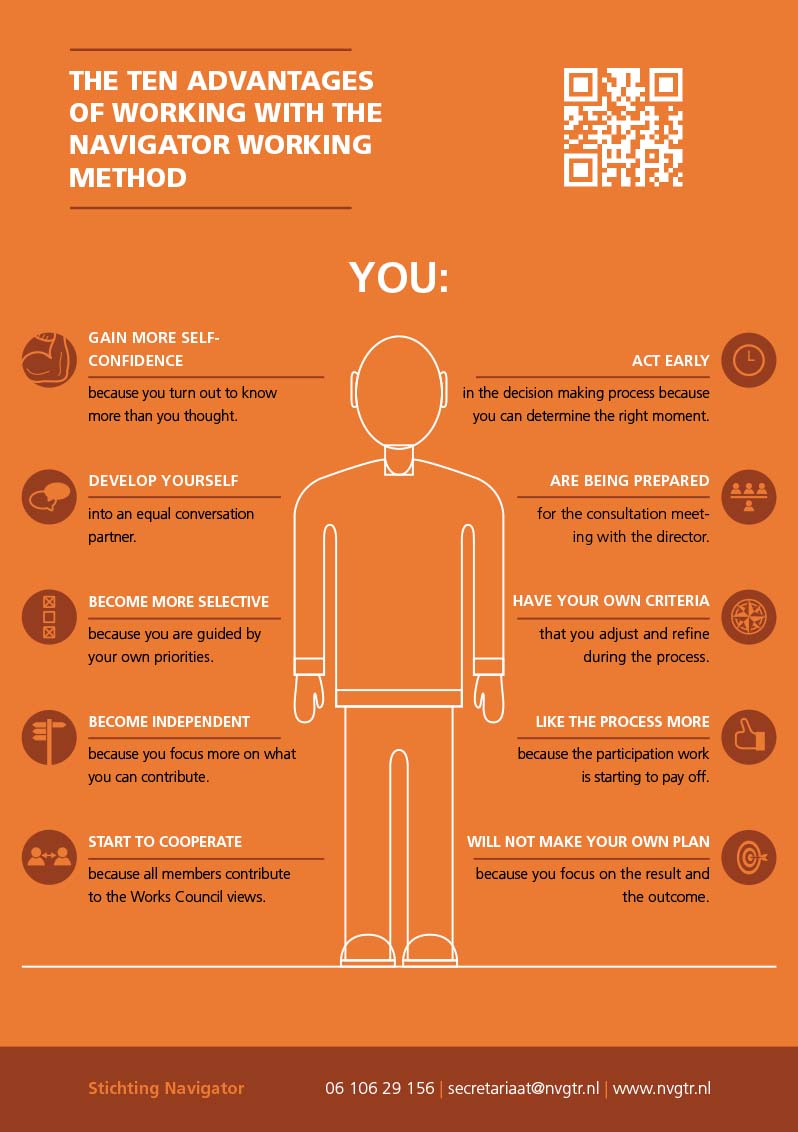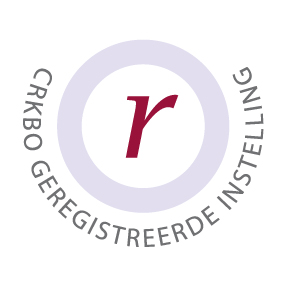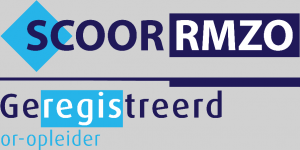Navigator - Working method of the Works Council and ERB

A smart and simple method for employee participation
The Navigator working method is a smart
and simple method for Works Councils.
This method aims for a proper representation
of the constituency of the Works Council and
to have an actual 1nfluence on the decisionmaklng
by the management
Quick progress can be made by uslng this
method and the Navigator ends the vicious
cirde of questions being asked again and
again. Employee participation becomes fun
again, also for the director who looks for
cooperation and general support within the
company.
The basic premises of the Navigator
- Statements instead of questions
- Acting instead of waiting
- Content instead of rules
Stop asking questions
Become a Navigator!
"Our director does not take us seriously. None of our questions are answered. We are informed either too late or not at all."
Do you recognize this common complaint amongst Works Councils? The good news is, it does not have to be like this!
Being informed
Works Councils tend to bombard the director with questions – which is understandable, as you want to get acquainted with all the facts before giving your opinion. You don't want to lose face by making statements that turn out to be incorrect. Besides, you have a right to a lot of information regarding the enterprise and workforce, based on Article 31 of the Works Council Act, particularly as regards topics subject to advisory powers or the right to endorse.
Stop waiting!
However, asking (a lot of) questions does make for a passive attitude: one tends to sit around and wait for the answers. This could take a long time, sometimes weeks or months. While the Works Council is waiting, the management train is pulling ahead. They look at a problem from all angles, research matters and consult with different parties. They also think about solutions to the problem and the respective pros and cons. All the while, the Works Council is waiting. And by the time answers are provided, those often turn out to be not specific enough for the Works Council. So the Works Council draws up a new set of questions, and waits for answers again.
Irritation
By this time, the director is getting annoyed. They see the Works Council as a many-headed dragon; every time you slice off one of the heads, seven new ones grow in its place. Every answer leads to new questions. On top of that, many Works Councils submit questions the director cannot answer. Such as: 'Will there be forced lay-offs?' or 'What will the organization structure look like?'. Questions like these can only be answered at a later date. They will follow from other deliberations and decisions that will have to be taken first.
Besides that, the director may be wondering why the Works Council needs all this detailed information. Are they going to re-do everything I did? Do they think they can? None of these factors motivate the director to cooperate with the Works Council. It is more of a pain than a pleasure for them.
Knowledgeable
This process is time-consuming and basically unnecessary, because the Works Council certainly is knowledgeable, but on a different matter. The Works Council may not have the same expertise as management regarding management tools. But they do have expertise in deciding what is important (or not) for employees and clients. Many Works Council members are part of the daily operations of the company and get a first-hand view from colleagues and clients. Without submitting a single question to the director about a subject, the Works Council can start to formulate their opinion on the topic. But the Works Council team will have to meet and take the time to do this. This time is in ample supply once you stop asking numerous questions and studying the documents management provides. There are ways to do this in an orderly and efficient manner. Furthermore, it is important that the Works Council systematically researches the workforce's opinion on different matters.
Navigator Working Method
The Dutch Ministry of Social Affairs and Employment has financed the development and the spread of a method that could help Works Councils gain more traction: the Navigator Werkmethode van de Ondernemingsraad en PVT® (Navigator Working Method for the Works Council and Employee Representative Bodies). This method uses off-road car rallies as a metaphor. In this racing sport the driver drives the car, based on the guidance given by the navigator sitting next to them. Employee participation works along similar lines: the director is in the driving seat and the Works Council offers advice and consent to help the entrepreneur do this optimally.
Premises
The Navigator Working Method has three premises.
1. Do not ask questions, but make statements
Every substantive question increases the Works Council's dependency. By declaring its own preliminary point of view, the Works Council will automatically be given the further information they need. There is no shame in having to change one's opinion if and when the other party provides new relevant information. A Works Council that takes a stand, is less dependent on their partner in the consultation.
2. Not passive, but proactive
If you're waiting to be asked for your opinion before you give it, you could be in for quite a long wait. And the longer you wait, the less your opinion will actually make a difference. Being informed at an early stage is not the same as being involved at an early stage. In the end, employee participation is all about optimizing the decision the director is intending to take. The only way to do that, is to provide input and create influence yourself.
3. Not because you have a right, but because you have real input
The Works Council does not become a serious consultation partner by waving the law around, but by initiating a knowledgable discussion about what should (and should not) be done.
That knowledge should definitely comprise knowledge of daily operations and clients, as management already has other types of knowledge at their disposal. The question 'What do our employees and clients think?' can best be answered by the people that represent these employees and clients.
Assessment points
Criteria, demands, or specifications – we call them 'assessment points'. These specify what the end result of the decision-making, and the process towards it, should adhere to. They define not the solutions per se, but the road to solution according the Works Council. Assessment points are the instrument by which the Works Council can influence the decision-making process at the earliest possible stage and can consult the colleagues involved. Every action will lead to an adjustment of the list of assessment points. It is a continually evolving outline of the Council's point of view. The Works Council will use the final list when deliberating a request for advice or consent.
An example of an assessment point about policy for sick leave: "The policy should be aimed at prevention, not repression."
Case study: Uniface
Uniface is a Dutch IT company, owned by an American investor. The Works Council foresaw that Uniface would probably be sold in the near future. It therefore put together a first list of assessment points to which the buyer and general situation should adhere after the sale. They submitted this list to the Dutch director. Developments followed quickly, but the result was that the American investor came to the Netherlands to talk to the Works Council. It was decided not to sell the company (yet), and even to invest in it more.
Benefits for representatives in employee participation
Thanks to the Navigator Working Method:
- You will become proactive;
- Colleagues will feel represented by you;
- You can influence decisions that are to be taken;
- Consultation will be meaningful;
- You can do more in less time;
- Employee participation will feel rewarding again.
Benefits for managers
Thanks to the Navigator Working Method:
- The decision-making process will no longer be delayed;
- Consultation will be meaningful;
- You can consult with people representing the staff's point of view;
- Communication proceeds along predicable lines;
- Management does not need to answer questions;
- There is a larger support base for necessary changes.
Written by Frank Dijkstra
Stichting Navigator
KvK: 32126470
BTW: 8184.74.075.B01
NL48INGB0004844888
Geregistreerd
De stichting Navigator - werkmethode van de ondernemingsraad en PVT® is als instelling geregistreerd bij het CRKBO. Alle opleiders zijn geregistreerd in het Register MZ-opleiders bij het Scoor/RMZO.


